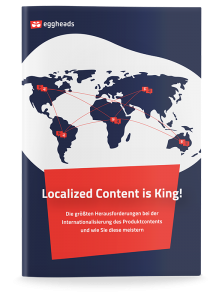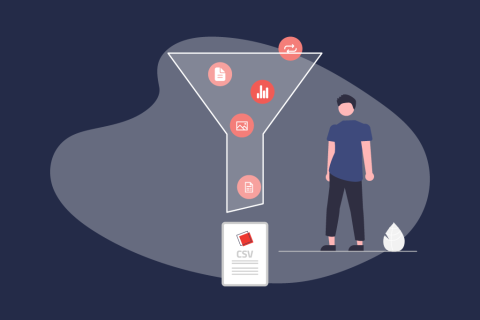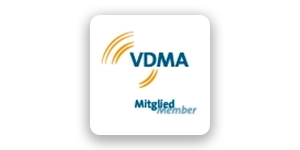Product Communications
Efficient and Automated: Translation Management directly in PIM

Content
How Effective are Translation Processes in PIM with and without a Translation Management System?
On a daily basis, companies internationalize and localize text content of all kinds – be it for products or services, be it information offers to B2B parties or B2C target groups. Sometimes in the form of internal datasheets travelling across corporate departments, at other times as published ads ranging from digital print catalogs to digital channels such as online shops and apps with multimedia content.
An integral part of the solution for optimally managing this colorful variety of content is a centralizing Product Information Management (PIM). Here, users pool together all data records and product texts, enrich them further, and, finally, distribute them to all relevant target channels. To this end, on the one hand, many PIM systems provide you with built-in functions for Translation Management. Yet, on the other hand, there are many more kinds of translation-relevant texts floating around in your company which are only indirectly related to product data. This is why there are Translation Management Systems (TMS) for all needs revolving around translations.
Now, considering this overlap between Content Management and Translation Management, the following questions naturally present themselves: Is it possible that a PIM with fully integrated translation functions all by itself can even replace a TMS tool? How about the alternative to simply outsource translation-relevant texts to freelance translators or translation agencies? Maybe a combination of both options is even more attractive – and, if so, what does this mean for data exchange and collaboration?
Lastly, the translation process is one of the most costly affairs when it comes to content creation. Even if you’re only offering your product in, say, the language of your main region together with an international language such as English. This is why we want to analyze the synergies between PIM and Translation Management from the viewpoint of the big picture in this blog post together with you.
How does Translation Management function and what is a Translation Memory?
In translation praxis, you can put your trust into a fast selection of helpful tools. Such tools are commonly summarized under the umbrella term Computer-Assisted Translation (CAT): The human being is doing the translation work, but digital assistance is provided in the form of spelling and grammar checkers, online dictionaries, and terminology or glossary lists for your industry of specialization. And in the case of Translation Memory Systems as all-in-one solutions, all benefits of these auxiliary resources are unified in a single, central CAT system. Just how a PIM system brings together all processes revolving around product data.
At the same time, the acronym TMS is often also synonymously interpreted as Translation Memory System. What does the word “memory” mean here? The system saves or, quite literally, memorizes all translated texts in all language pairs. It does so under the principle of “segment-based translations”: Continuous texts are divided into the smallest semantically meaningful unit, namely sentences. This segmentation is coupled with an alignment of the sentence in the source language (SL) and its respective target language (TL). On the word level, the system additionally memorizes all your company’s newly translated terminology. All this serves the following purpose: When translators work with new texts in the integrated text and translation editor, the system automatically compares to-be-translated sentences with all already translated sentences in the database. Accordingly, matching translation and terminology suggestions are directly displayed in real time.
- „100-Percent Match“: There is a 1:1 correspondence between the to-be-translated sentence and an already translated sentence.
- „Fuzzy Match“: There is a partial correspondence with an already translated sentence. Both TMS and PIM systems can calculate the exact percentage of overlap and can rank suggestions accordingly, starting with the most relevant suggestion.
With that, translators have a field day. They evaluate recommended suggestions and adopt them at the click of a button – depending on the use case, the translator can then finish the translation of the text or adjust it to the given context together with other finishing touches. And, once again, the system does also memorize these newly translated sentences for future translation projects. This way, your company maintains a valuable multi-lingual text corpus for all its texts and data.
Main Benefits of TMS-Tools for PIM
The benefits of a Translation Management System are more than obvious: The segmented-based translation alone with its real-time translation and terminology suggestions has much to offer…
- Fast and efficient translation process
- Avoid repetitions and redundancy
- Consistent tone and style for securing your corporate language across all regions
- Collaboration and division of labor for text editing and translation
- Creating automated machine-based translations in combination with post-editing work by human translators
The costs saved multiply if your factor in the creation of different text variants, for different target groups, on different target platforms – and increases exponentially for each additional target language.
Besides translation functions, almost all Translation Management Systems take care of the entire user-defined translation workflow. From the creation of the translation task to the billing on the basis of word count or time required for the translation. This is how Translation Management centralizes all functions and processes for localizing content – on the opposite end, however, it does only cover a fraction of the internationalization process, as we shall now see.
PIM as a Solution for Translation Processes – without TMS?
PIM, too, is a comprehensive system solution: As early as in the stage of data analysis, as part of the initial PIM implementation project, all product attributes of your assortment down to the very last article are checked extensively for translation relevance and internationalization potential. Language settings are an integral part of a company’s own data model, as actively managed and maintained by the PIM users. Depending on the setup of the data model of a company, this does not only include product and service data, but also analytics and supplier data. This way, PIM creates the ideal data foundation for all language-dependent use cases, one of which is internationalization.
A further enabling condition is the regular creation of translation tasks for data and content. In the industry, we refer to this field as “Translation Management”: Translation managers evaluate translation-relevant content, define translation projects, and accompany them throughout until the quality assurance is complete.
Concerning the evaluation of translation-relevant texts, too, you’re sitting right at the “single source of truth” thanks to PIM. Equipped with extensive search functions and user-defined search criteria, translation managers analyze all data records at the click of a few buttons, for example for the purposes such as: spotting currently untranslated attributes of actual products, translations which are outdated, or product texts which don’t match the user-defined data quality rules.
On the basis of such a well-selected set of data objects in the form of search results, a translation project can be created directly. This includes defining parameters such as relevant language pair(s), additional filters for selecting only translation-relevant data objects required for the current use case, due date, and the translators in charge. As part of the integrated workflow of your PIM, such translation projects can then be translated either directly in the text editors of the system – or outsourced accordingly, be it to a connected in-house Translation Management System or an external translation agency.
When completing the project, the PIM system knows exactly where translated data records belong to and directly stores them at the relevant data objects with their product attributes. Thus, a gapless process comes to its closure.
In short: Even by itself, PIM software is already an excellent Translation Management solution for data of all sorts. Some PIM systems even have a dedicated software module for translation functions to offer. However, without TMS connectivity, your in-house translators will have to fall back to the Computer-Assisted Translation tools (CAT) mentioned above – these alternatives are usually available for free. While it’s true that elaborate Translation Memories, in turn, come with licensing fees, they will easily pay dividends given that they simplify the entire translation process from start to finish in an all-encompassing manner.
Synergy between PIM and Translation Management
Last but not least, let’s have a closer look at the PIM-plus-TMS synergy. PIM solutions are explicitly designed to systematically pool together all your company’s data. Which is why connecting third-party systems poses no challenge whatsoever – be it a Translation or a Content Management System. All data exchanges are enabled thanks to the “XLIFF” translation exchange format – this way, even the active collaboration with external translation agencies is a secure alternative. Specialized PIM solutions can even process translation and terminology suggestions in real time as provided by the connected Translation Memory, displaying them directly in the text editors of the PIM’s graphical user interface. Starting from the opposite direction, you can also transfer translations created in PIM over to the TMS. Such features, in turn, are based on conventional “REST” interfaces as an out-of-the-box function which is standard for most Translation Management Systems.
And let’s not forget about the content creators and marketers who work with PIM either. They, too, can check translation and terminology suggestions for their source-language texts in the PIM text editors. This means that they can already start internationalizing content as they write it. If you have a PIM with print or DTP functions in place, you can even set up user-defined templates for publications tailor-made for relevant target platforms and make use of dynamics and automatisms to fill them with content at the click of a few buttons – namely, in each relevant target data language. Once a new content cycle draws near on your agenda, you can simply re-use these templates again and let your designers add the finishing touches to adjust things to the current use case. This is how some of our customers supply physical and digital channels internationally in more than 30 languages with the help of our PIM system, eggheads Suite.
From Our Blog
You may also be interested in the following articles








